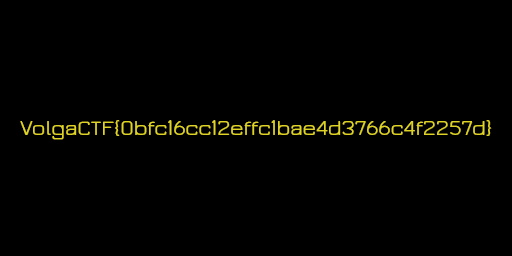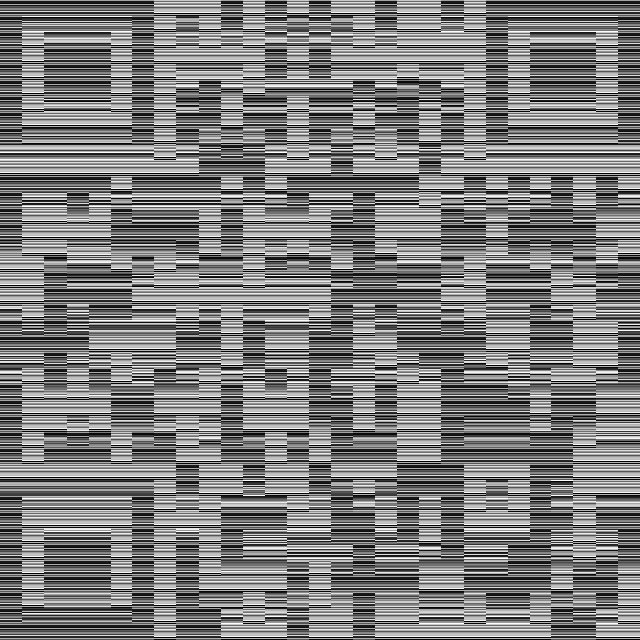VolgaCTF 2021 Writeup
Mon Mar 29 2021
I participated in VolgaCTF 2021 as a member of WreckTheLine. The results was 14th/231 (within teams with positive points). I solved 2 crypto problems, "QR Codebook" and "Carry". This is a writeup for those.
Crypto
QR Codebook
We were given 3 images.
- img: QR which says "Helpful_Information"
-
- img_enc: Processed QR from above img
-
- img_flag_enc: Processed QR from FLAG QR
-
We didn't have any other information, so let's observe. My observation revealed the following:
- To see images in a row, continuous numbers occur
- ex. the first raw of img_enc is [164, 164, ..., 164, 164, 201, 201, ..., 201, 201, 164, ..., 164, 201, ..., 201, ...]
- To see images in a column, the same patterns appear many times (16 cycles)
- ex. the first column of img_enc is [164, 25, 22, 17, 172, 23, 87, 71, 132, 139, 59, 221, 39, 32, 173, 89, 164, 25, 22, 17, 172, 23, 87, 71, 132, 139, 59, 221, 39, 32, 173, 89, ...]
- Column patterns are the same between img_enc and img_flag_enc
- At each dot the RGB values are the same in img_enc
I guessed that there is one-to-one mapping from img[i: i+16, j] to img_enc[i: i+16, j, k] for all . Let's try to find that mapping and apply it to img_flag_enc.
solve.pyimport matplotlib.pyplot as plt import numpy as np from PIL import Image # 0 is black, 1 (255) is white. img_enc = np.array(Image.open("./qr.encrypted.png")) img_flag_enc = np.array(Image.open("./flag.encrypted.png")) img = np.array(Image.open("./qr.png")) img_size = img.shape[0] assert img_size == img_enc.shape[0] == img_enc.shape[1] enc_to_dec = {} for i in range(0, img_size, 16): for j in range(img_size): tmp = tuple(img_enc[i : i + 16, j, 0]) if tmp not in enc_to_dec: enc_to_dec[tmp] = img[i : i + 16, j] c = 0 img_flag = np.ones(img_flag_enc.shape[:2]) for i in range(0, img_flag_enc.shape[0], 16): for j in range(img_flag_enc.shape[1]): tmp = tuple(img_flag_enc[i : i + 16, j, 0]) if tmp in enc_to_dec: img_flag[i : i + 16, j] = enc_to_dec[tmp] plt.imshow(img_flag, cmap="gray") plt.savefig("./flag.png")

There seem some incorrect dots in QR... Since each dots in QR code are bigger than 16 pixels, we can reconstruct from this image to the correct QR code in theory. But my smart phone can read this broken QR code correctly (smart!).
VolgaCTF{S0m3tim35_3C8_c4n_b3_t00_pr3dict4b13}
Carry
We were given a shift register (FCSR) and an image xor-ed by bits generated from that register. The state of the register wasn't disclosed. The implementation of FCSR was as follow:
fcsr.pyclass FCSR(): def __init__(self, q: int, m: int, a: int): self.m = m self.q = q + 1 self.k = int(math.log(q, 2)) self.a = a @staticmethod def get_i(n: int, i: int) -> int: # right to left return (n & (0b1 << i)) >> i def clock(self) -> int: s = self.m for i in range(1, self.k + 1): s += self.get_i(self.q, i) * self.get_i(self.a, self.k - i) a_k = s % 2 a_0 = self.a & 0b1 self.m = s // 2 self.a = (self.a >> 1) | (a_k << (self.k - 1)) return a_0 def encrypt(self, data: bytes) -> bytes: encrypted = b'' for byte in data: key_byte = 0 for _ in range(8): bit = self.clock() key_byte = (key_byte << 1) | bit encrypted += int.to_bytes(key_byte ^ byte, 1, 'big') return encrypted
Since the first 16 bytes of a PNG file are fixed, the 128 generated bits can be calculated.
[0, 1, 1, 0, 1, 1, 1, 0, 0, 0, 1, 1, 0, 1, 1, 0, 1, 0, 1, 0, 0, 0, 1, 0, 0, 0, 0, 0, 1, 0, 1, 1, 0, 0, 0, 0, 1, 1, 1, 0, 0, 1, 0, 0, 1, 0, 1, 0, 1, 1, 1, 0, 1, 1, 1, 1, 1, 0, 1, 0, 0, 1, 1, 1, 1, 0, 0, 0, 1, 1, 0, 1, 1, 0, 1, 0, 1, 0, 0, 0, 1, 0, 0, 0, 0, 0, 1, 0, 1, 1, 0, 0, 0, 0, 1, 1, 1, 0, 0, 1, 0, 0, 1, 0, 1, 0, 1, 1, 1, 0, 1, 1, 1, 1, 1, 0, 1, 0, 0, 1, 1, 1, 1, 0, 0, 0, 1, 1]
From some experiments, I found that FCSR generated cyclic bits at short period when chosen parameters were bad. Looking at this problem carefully, I noticed that there was a cycle like [0, 1, 1, 0, 1, 0, 1, 0, 0, 0, 1, 0, 0, 0, 0, 0, 1, 0, 1, 1, 0, 0, 0, 0, 1, 1, 1, 0, 0, 1, 0, 0, 1, 0, 1, 0, 1, 1, 1, 0, 1, 1, 1, 1, 1, 0, 1, 0, 0, 1, 1, 1, 1, 0, 0, 0, 1, 1].
solve.pyfrom Crypto.Util.number import bytes_to_long, long_to_bytes from fcsr import FCSR with open("./encrypted_png", "rb") as f: buf = f.read() def xor(a, b): return bytes([_a ^ _b for _a, _b in zip(a, b)]) png_header = b"\x89\x50\x4e\x47\x0d\x0a\x1a\x0a" + b"\x00\x00\x00\x0d\x49\x48\x44\x52" first_bytes = xor(png_header, buf) first_bytes_long = bytes_to_long(first_bytes) first_bits = list(map(int, f"{first_bytes_long:0128b}")) # known bits: 16 * 8 = 128 cycle = [0, 1, 1, 0, 1, 0, 1, 0, 0, 0, 1, 0, 0, 0, 0, 0, 1, 0, 1, 1, 0, 0, 0, 0, 1, 1, 1, 0, 0, 1, 0, 0, 1, 0, 1, 0, 1, 1, 1, 0, 1, 1, 1, 1, 1, 0, 1, 0, 0, 1, 1, 1, 1, 0, 0, 0, 1, 1] bits = first_bits + ((8 * len(buf) - len(first_bits)) // len(cycle) + 1) * cycle all_bytes = b"" for i in range(0, len(bits), 8): all_bytes += long_to_bytes(sum([b * 2 ** (7 - j) for j, b in enumerate(bits[i: i+8])])) ans = xor(all_bytes, buf) with open("dec.png", "wb") as f: f.write(ans)

VolgaCTF{0bfc16cc12effc1bae4d3766c4f2257d}


